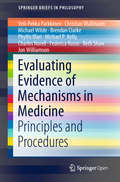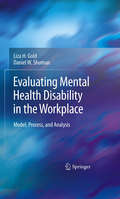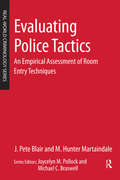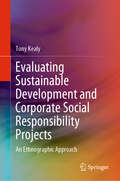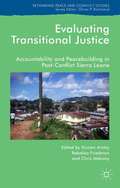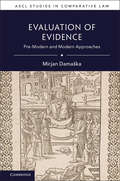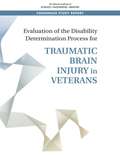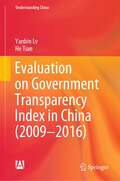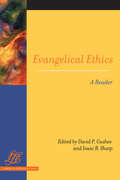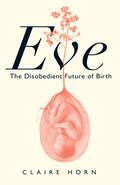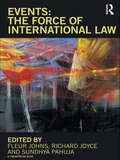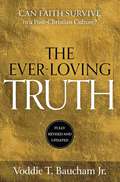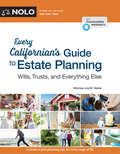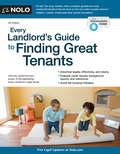- Table View
- List View
Evaluating Evidence of Mechanisms in Medicine: Principles and Procedures (SpringerBriefs in Philosophy)
by Beth Shaw Phyllis Illari Veli-Pekka Parkkinen Christian Wallmann Michael Wilde Brendan Clarke Michael P Kelly Charles Norell Federica Russo Jon WilliamsonThis book is open access under a CC BY license. This book is the first to develop explicit methods for evaluating evidence of mechanisms in the field of medicine. It explains why it can be important to make this evidence explicit, and describes how to take such evidence into account in the evidence appraisal process. In addition, it develops procedures for seeking evidence of mechanisms, for evaluating evidence of mechanisms, and for combining this evaluation with evidence of association in order to yield an overall assessment of effectiveness. Evidence-based medicine seeks to achieve improved health outcomes by making evidence explicit and by developing explicit methods for evaluating it. To date, evidence-based medicine has largely focused on evidence of association produced by clinical studies. As such, it has tended to overlook evidence of pathophysiological mechanisms and evidence of the mechanisms of action of interventions. The book offers a useful guide for all those whose work involves evaluating evidence in the health sciences, including those who need to determine the effectiveness of health interventions and those who need to ascertain the effects of environmental exposures.
Evaluating Mental Health Disability in the Workplace
by Liza H. Gold Daniel W. ShumanAs many as one in four adults in the workforce will suffer from psychiatric illness in a given year. Such illness can have serious consequences -- job loss, lawsuits, workplace violence--yet the effects of mental health issues on job functioning are rarely covered in clinical training. In addition, clinicians are often asked to provide opinions on an employee's fitness for work or an evaluation for disability benefits, only to find themselves embroiled in complex legal and administrative conflicts. A unique collaboration between a renowned clinical professor of psychiatry and a noted legal expert, Evaluating Mental Health Disability in the Workplace approaches the topic from two distinct areas: the legal context and issues relevant to disability and disability-related evaluations, and the interplay of factors in the relationship between work and psychiatric illness. From this dual perspective, the authors advocate for higher professional standards ensuring that employers, evaluees, or third parties are provided with the most reliable information. Key features of the book: A robust assessment model of psychological disability in the workplace Practice guidelines for conducting workplace mental health disability evaluations Legal and ethical aspects of employment evaluations, especially as they differ from clinical procedure Examination of the process of psychiatric disability development Issues specific to evaluations for Social Security, Workers' Compensation, and other disability benefit programs Review of relevant administrative and case law. As an introduction to these complex issues or for the further improvement of evaluation skills, Evaluating Mental Health Disability in the Workplace is a timely reference for psychiatrists, psychologists, forensic mental health specialists, and attorneys in this field.
Evaluating Police Tactics: An Empirical Assessment of Room Entry Techniques
by J. Pete Blair M. Hunter MartaindaleThe approach that should be used by law enforcement officers in order to safely and effectively enter a room is a point of contention among many police trainers. Based on five experiments conducted over a two-year period, Evaluating Police Tactics demonstrates that the conventional wisdom is not optimal. Using the scientific method to systematically assess current room entry philosophies and techniques employed by police, Evaluating Police Tactics offers suggestions for examining the current philosophies and determining how patrol officers can enter scenes of ongoing violence, find the shooter, and stop the killing as safely and effectively as possible. About the Real-World Criminology Series More than just textbooks, the short books in the Real-World Criminology series are designed to be of interest to particular fields within criminology. They can be policy primers, spurring innovations in policing and corrections, theoretical works dealing with policy implications, or program evaluations incorporating theoretical foundations. Each book covers something that is happening –or should be happening—in the world of criminal justice.
Evaluating Sustainable Development and Corporate Social Responsibility Projects: An Ethnographic Approach
by Tony KealyThis book discusses sustainable development decision-making. Focusing on decisions to invest in wind turbine technology as part of a corporation’s CO2 emission reduction strategy, it presents a new evaluation framework, based on the triple bottom line framework widely used by businesses to communicate their adherence to corporate social responsibility. This new framework allows the evaluation of strategic corporate decisions to invest in wind turbines to mitigate global warming in the context of a corporation’s social responsibility, and includes an objective measurement stage to add rigor to the evaluation process. The book describes the use of measured data from wind turbine projects to both develop and validate the methodology, and also identifies key enablers and barriers as businesses attempt to successfully integrate corporate social responsibility into their overall business strategy. Given its scope, the book appeals to postgraduate students, researchers, and business professionals interested in the environmental impact of corporations. Featuring case studies from Ireland, it is particularly relevant to audiences within Europe.
Evaluating Transitional Justice
by Kirsten Ainley Rebekka Friedman Chris MahonyDemonstrating groundbreaking analysis, this is the first major study to evaluate the transitional justice programme in Sierra Leone. Rather than focusing on a single mechanism, the authors examine how the Special Court, Truth and Reconciliation Commission (TRC), local justice initiatives and reparations programme interacted. Contributors to the book include the Prosecutor of the Special Court and one of the Commissioners from the TRC, alongside a range of experts on transitional justice, oninternational law and on Sierra Leone. The authors consider the political and normative drivers of transitional justice and the lessons that the Sierra Leone programme stands to offer other post-conflict situations. The importance of long-term planning, local partnership and the management of the politics and trade-offs for future transitional justice programmes cannot be underestimated. This edited volume makes a significant contribution to the field by demonstrating how contextual knowledge should be used alongside normative standards when evaluating transitional justice.
Evaluation of Evidence: Pre-Modern and Modern Approaches (ASCL Studies in Comparative Law)
by Mirjan DamaškaJudges were never bound by law to convict a defendant unless they considered him guilty. Yet, they could be prohibited by law from convicting a person they consider guilty due to the absence of legally prescribed or the presence of legally prohibited evidence. Evaluation of Evidence addresses the question: should the law restrict the freedom of judges in assessing the probative value of evidence in the criminal process? Tracing the treatment of evidence from pre-modern to modern times, Mirjan Damaška argues that there has always been some understanding about rules regarding the use and treatment of evidence, and these rules should not be looked askance as a departure from ideal arrangements. In a time when science and technology have the ability to contribute to factual inquiry, there needs to be acceptance of rules that expand or corroborate evidence produced by our native sensory apparatus.
Evaluation of the Disability Determination Process for Traumatic Brain Injury in Veterans
by Engineering Medicine National Academies of SciencesThe Veterans Benefits Administration (VBA) provides disability compensation to veterans with a service-connected injury, and to receive disability compensation from the Department of Veterans Affairs (VA), a veteran must submit a claim or have a claim submitted on his or her behalf. Evaluation of the Disability Determination Process for Traumatic Brain Injury in Veterans reviews the process by which the VA assesses impairments resulting from traumatic brain injury for purposes of awarding disability compensation. This report also provides recommendations for legislative or administrative action for improving the adjudication of veterans’ claims seeking entitlement to compensation for all impairments arising from a traumatic brain injury.
Evaluation on Government Transparency Index in China (Understanding China)
by He Tian Yanbin LvThis book presents the outcomes of a study on indices of rule by law in China conducted by the Chinese Academy of Social Sciences (CASS). Since 2009, a group of researchers at the CASS Institute of Law has worked to assess the Chinese government’s transparency. In this context, they designed an index system to truthfully record and reflect the reality and development of openness in the Chinese government for eight consecutive years. This book compiles their reports on each year’s development, systematically combining quantitative analysis and the status quo for each year. Thanks to these reports, readers will be able to clearly understand the evolution of the Chinese government’s openness during these eight years. They highlight what the government has done to improve transparency, what has been achieved, and the goals for the future. These reports have not only been acclaimed in academic circles, but have also greatly influenced government policies and procedures. For example, the assessment was expanded to the judicial system including the Supreme People’s Court, maritime court, and local provincial courts in 2011, and ever since the national judicial system’s openness has been considerably improved, in response to recommendations based on the assessment.
Evangelical Ethics
by Edited by David P. Gushee Isaac B. SharpJust as it is impossible to understand the American religious landscape without some familiarity with evangelicalism, one cannot grasp the shape of contemporary Christian ethics without knowing the contributions of evangelical Protestants. This newest addition to the Library of Theological Ethics series begins by examining the core dynamic with which all evangelical ethics grapples: belief in an authoritative, inspired, and unchanging biblical text on the one hand, and engagement with a rapidly evolving and increasingly post-Christian culture on the other. It explores the different roles that scholars and popular figures have played in forming evangelicals' understandings of Christian ethics. And it draws together the contributions of both senior and emerging figures in painting a portrait of this diverse, vibrant, and challenging theological and ethical tradition. This book represents the breadth of evangelical ethical voices, demonstrating that evangelical ethics involves nuance and theological insight that far transcend any political agenda. Contributors includeDavid P. Gushee, Carl F. H. Henry, Jennifer McBride, Stephen Charles Mott, William E. Pannell, John Perkins, Soong-Chan Rah, Gabriel Salguero, Francis Schaeffer, Ron Sider, Helene Slessarev-Jamir, Glen H. Stassen, Eldin Villafa#65533;e, Allen Verhey, Jim Wallis, Nicholas Wolterstorff, and John Howard Yoder. The Library of Theological Ethics series focuses on what it means to think theologically and ethically. It presents a selection of important, and otherwise unavailable, texts--English-language texts and translations that have fallen out of print, new translations, and collections of significant statements about problems and themes of special importance--in an easily accessible form. This series enables sustained dialogue on new and classic works in the field.
Eve: The Disobedient Future of Birth
by Claire HornA radical interrogation of the ethics and future of birth by an expert legal scholar. Every single one of us has been born from a person. So far. But that is about to change. For the first time, babies could be gestated and born from machines through “Ex-vivo Uterine Environment Therapy,” aka EVE. But such radical technology leaves us with complex legal, social, and ethical questions. What does this breakthrough in artificial human gestation mean for motherhood, womanhood, and parenthood? Countries and people that do not respect the autonomy of pregnant people may use these technologies to curtail choice further, advance eugenic ideas, or to deepen class and racial divides. In this fascinating story of modern birth, Claire Horn takes us on a journey from the first orchid-like incubators in the 1880s to the cutting-edge scientific breakthroughs of today. As she explores the most challenging and pertinent questions of our age, Horn reflects on her own pregnancy. Could artificial wombs allow women to redistribute the work of gestating? How do we protect reproductive and abortion rights? And who exactly gets access to this technology, in our vastly unequal world?
Even When You Lie: A Novel
by Michelle CruzPerfect for fans of Lisa Scottoline and Kimberly McCreight, Michelle Cruz's debut novel will have readers furiously turning the pages as they plunge headlong into the seedy underbelly of glitzy and glamorous Dallas in this gripping Texas noir.Reagan Reyes hunts other people&’s secrets. A former intelligence officer, she&’s currently the in-house investigator for pricey criminal defense attorney, Cade McCarrick…and she&’s his lover, despite the law firm&’s rules forbidding romantic relationships between partners and staff. But their love—including their agreement never to lie to each other—is the only authenticity they have in a world of subterfuge and betrayal.That agreement is pushed to its limits when a mysterious woman leaves an envelope for Cade and is soon discovered dead. While the envelope&’s contents aren&’t related to any of Cade&’s current cases, Reagan uncovers a connection to a recent murder outside a Deep Ellum nightclub—and an even more ominous link to the dead woman.The police don&’t seem to care about either death, but they hit too close to home for Reagan to ignore. As she digs deeper into Dallas&’s sordid underbelly, she&’s completely on her own except for Cade—and there&’s a killer bent on eliminating them both at any cost.This pulse-pounding romantic thriller offers a fresh new take on big-city crime, from a dazzling and exciting new voice in the genre.
Even the Devil Quotes Scripture: Reading the Bible on Its Own Terms
by Robyn J. Whitaker&“We are meant to take the Bible seriously, not literally.&” —from the Introduction In Even the Devil Quotes Scripture, Robyn J. Whitaker looks to the Bible as a guide to interpreting the Bible, and her findings breathe new life into our understanding and use of Scripture. As it turns out, the uses of Scripture within Scripture are flexible, open to frequent reinterpretation, and rarely literal.For instance, Ezra and Nehemiah reinterpret laws about whether Jews can marry foreigners in the wake of the Babylonian exile. Their contradiction of earlier traditions found in Deuteronomic law do not invalidate Scripture but rather represent its diverse applications for the prophets&’ specific situations. In the Gospel of Matthew, Jesus presents a more demanding interpretation of Mosaic law in the Sermon on the Mount, while in Mark&’s Gospel he all but ignores its prohibition of working on the Sabbath. Yet the common ethos of the two gospels prioritizes compassion over legalism.Ultimately, Whitaker ascertains one definitive characteristic of inner-biblical interpretation: love. After all, the Old Testament passage most frequently quoted in the New Testament is Leviticus 19:18: &“Love thy neighbor.&” Thus, Whitaker proposes a hermeneutic of love—a litmus test for the validity of a scriptural interpretation measured in charity. Ideal for any devoted reader of the Bible, Even the Devil Quotes Scripture opens our eyes to the Bible as a living, loving gift of God&’s unfolding revelation.
Evening Thoughts: Reflecting on Earth as Sacred Community
by Thomas Berry Mary Evelyn TuckerAmong the contemporary voices for the Earth, none resonates like that of noted cultural historian Thomas Berry. His teaching and writings have inspired a generation's thinking about humankind's place in the Earth community and the universe, engendering widespread critical acclaim and a documentary film on his life and work.This new collection of essays, from various years and occasions, expands and deepens ideas articulated in his earlier writings and also breaks new ground. Berry opens our eyes to the full dimensions of the ecological crisis, framing it as a crisis of spiritual vision. Applying his formidable erudition in cultural history, science, and comparative religions, he forges a compelling narrative of creation and communion that reconciles modern evolutionary thinking and traditional religious insights concerning our integral role in Earth's society.While sounding an urgent alarm at our current dilemma, Berry inspires us to reclaim our role as the consciousness of the universe and thereby begin to create a true partnership with the Earth community. With Evening Thoughts, this wise elder has lit another beacon to lead us home.
Events: The Force Of International Law
by Fleur JohnsEvents: The Force of International Law presents an analysis of international law, centred upon those historical and recent events in which international law has exerted, or acquired, its force. From Spanish colonization and the Peace of Westphalia, through the release of Nelson Mandela and the Rwandan genocide, and to recent international trade negotiations and the 'torture memos', each chapter in this book focuses on a specific international legal event. Short and accessible to the non-specialist reader, these chapters consider what forces are put into play when international law is invoked, as it is so frequently today, by lawyers, laypeople, or leaders. At the same time, they also reflect on what is entailed in naming these ‘events’ of international law and how international law grapples with their disruptive potential. Engaging economic, military, cultural, political, philosophical and technical fields, Events: The Force of International Law will be of interest to international lawyers and scholars of international relations, legal history, diplomatic history, war and/or peace studies, and legal theory. It is also intended to be read and appreciated by anyone familiar with appeals to international law from the general media, and curious about the limits and possibilities occasioned, or the forces mobilised, by that appeal.
Ever-Loving Truth: Can Faith Thrive in a Post-Christian Culture?
by Voddie T. Baucham Jr.Truth is under attack. The gospel is under attack. We must be aware and equipped if we are going to respond.Voddie Baucham has a message for Christians in today&’s culture—it&’s time to take a stand for the truth. In The Ever-Loving Truth, this powerful preacher and teacher addresses the cost of being a twenty-first-century Christian and helps readers apply the unchanging truth of God&’s Word to contemporary life issues. The book draws parallels between committed Christians in our society and the New Testament writers, Peter and John, as followers of Christ who proclaimed and stood for truth in their non-Christian environment. You will find this compelling study leads you to evaluate what it means to be a Christian today and how to apply God&’s unchanging truth to a variety of circumstances.
Everglades Patrol
by Tom ShirleyAs law enforcement officer and game manager for the Florida Game and Fresh Water Fish Commission, Lt. Tom Shirley was the law in one of the last true frontiers in the nation--the Florida Everglades.In Everglades Patrol, Shirley shares the stories from his beat--an ecosystem larger than the state of Rhode Island. His vivid narrative includes dangerous tales of hunting down rogue gladesmen and gators and airboat chases through the wetlands in search of illegal hunters and moonshiners.During his thirty-year career (1955-1985), Shirley saw the Glades go from frontier wilderness to "ruination" at the hands of the Army Corps of Engineers. He watched as dikes cut off the water flow and controlled floods submerged islands that had supported man and animals for 3,000 years, killing much of the wildlife he was sworn to protect.
Everlasting Love
by Linda FordHolly Hope surrounds herself with romance, even at work. Her cafe, Java Moi, is a haven for people in love. She simply adores special moments, thoughtful gestures - all the charm of romantic love. Steele Davis, on the other hand, lives up to his name. As an attorney who's hardened by life and the people he counsels in divorce proceedings, he has no time for such starry-eyed silliness. So when their pastor puts Steele and Holly together as a committee of two to plan a benefit banquet, sparks begin to fly. Coming from such opposite corners, can these two find a middle ground where love--and lasting love can grow?
Every Airbnb Host's Tax Guide
by Stephen FishmanThe complete tax guide for Airbnb and other short-term rental hosts As a short-term rental host, you’re entitled to many valuable deductions and other tax benefits. This book—the first of its kind—shows you how to pay no more tax than necessary on your rental income while complying with IRS rules. Learn everything you need to know about taxes, including: what deductions you should be taking how to report your short-term rental income how to deduct losses vacation home and tax-free rental rules how to allocate costs when you rent a room in your home, and how to keep proper records. Whether you rent your property through Airbnb, FlipKey, HomeAway, TripAdvisor, Craigslist, or VRBO, you want to make sure you understand these tax rules. That way, you can rest assured you are making the most out of your hosting business without risking problems with the IRS. All the information in the book remains up-to-date for the 2017 tax year. The changes brought about by the Tax Cuts and Jobs Act all take effect in 2018, except for an increase in bonus depreciation which took effect September 27, 2017. Anyone who purchases the book has access to an update page on the Nolo website specific to this book which explains the 2017 bonus depreciation change and summarizes how the new tax law affects small business owners’ taxes for 2018 and later. A new edition of the book, completely updated for the new tax law, will be published August 1, 2018.
Every Airbnb Host's Tax Guide
by Stephen FishmanThe complete tax guide for Airbnb and other short-term rental hosts As a short-term rental host, you’re entitled to many valuable deductions and other tax benefits. This book—the first of its kind—shows you how to make the most out of your hosting business without risking problems with the IRS. Learn everything you need to know about taxes, including: what deductions you should be taking how to report your short-term rental income how to deduct losses and vacation home and tax-free rental rules. This book focuses on the unique tax issues arising from renting residential or vacation property through online rental platforms like Airbnb, FlipKey, TripAdvisor, Craigslist, and VRBO. Every short-term rental host needs to understand these tax rules to ensure they take all the deductions to which they are entitled, pay no more tax than is legally required, and stay out of trouble with the IRS. This book provides all of this information in a practical, easy-to-understand way.
Every Californian's Guide To Estate Planning: Wills, Trust & Everything Else
by Liza HanksEstate planning books often fall into two categories: Those that are overwhelming and full of jargon, focusing on strategies to avoid taxes, or those that provide a general overview of wills, trusts, and estate planning tools and issues at a basic level. Every Californian's Guide to Estate Planning is different: It focuses on estate planning issues that are unique to people who call California home. California is different from almost anywhere else, people come from all over the world to live here, less than 25% of our families fit the traditional model, property is subject to community property rules, and our property tax rates are kept low until a property changes hands. No other estate planning book on the market addresses international issues, how to plan for blended families, how and why community property matters in an estate plan, or how to pass low property taxes on to your children. Written by an estate planning attorney with more than 15 years of experience, complex issues are explained in clear and concise language with lots of examples based on real life stories.
Every Californian's Guide To Estate Planning: Wills, Trust & Everything Else
by Liza W. HanksFinally, an Estate Planning Guide Written by and for Californians Every Californian’s Guide to Estate Planning helps you understand the basics of leaving money and property to loved ones and charities, naming a guardian for children, and planning for beloved pets—with a special focus on issues unique to making an estate plan in California, like: how state community property rules affect inheritance and taxes how to minimize capital gains for those inheriting high value real estate legal and tax rules that apply to non-citizens and U.S. permanent residents important issues for international guardians, trustees, and executors how to make sure your heirs don’t lose a low property tax rate, and how to avoid California’s slow and expensive probate system through options such as transfer-on-death deeds. Includes access to essential worksheets that help you get started on writing a will, preparing a trust, choosing a guardian, leaving money to kids, naming beneficiaries, choosing agents for your health care directive and power of attorney for finances, doing a personal inventory, and more.
Every Dog's Legal Guide: A Must-Have Book for Your Owner (5th Ed.)
by Mary RandolphAmerica's canine population is governed by many things: the nose, the stomach -- and the law. It is essential that dog owners and their neighbors know the ins and outs of various dog-related laws; including those regarding: - biting and barking - veterinarians - leash requirements - travel - landlords - wills - guide dogs - pit bulls - cruelty - and more. Unleashed by Nolo in 1988, Dog Law has been serialized in Redbook and the Los Angeles Times.
Every Employee's Guide to the Law
by Lewin G. JoelCovering every aspect of employment from the job interview to post-employment benefits, this invaluable resource focuses on employee rights guaranteed by law and explains how workers can be protected. In language praised for its clarity and accessiblity, this updated edition provides a strong foundation of legal knowledge and advice on wages and hours, health and safety, harassment, invasion of privacy, discipline, enemployment compensation, and more. 448 pp. Radio publicity. Author tour. 15,000 print.
Every Landlord's Guide to Finding Great Tenants
by Janet PortmanChoosing tenants is a landlord's most important (and most risky) decision -- find out how to do it safely and legally!
Every Landlord's Guide to Finding Great Tenants
by Janet PortmanSearching for the perfect tenant? Get the only book devoted to the most important decision a landlord can make! Landlords face many challenges, but choosing new tenants has the greatest potential to affect your bottom line. Fortunately, Every Landlord's Guide to Finding Great Tenants can help you find the right tenant for your rental property! Let this book guide you through the process of attracting, screening and selecting the best renters available. Get timely advice on: effective advertising phone screening presenting the unit evaluating applications examining credit reports checking references discrimination basics making a rental offer, and rejecting applicants. Every Landlord's Guide to Finding Great Tenants provides dozens of forms and checklists for every step, with easy instructions to fill them out. This edition has been fully updated to reflect the latest changes in the law in your state, including rules about checking a potential tenant's immigration status. Plus, get all the legal forms you need, as well as invaluable audio dialogues that show you how to conduct interviews and get essential information without running afoul of the law.
